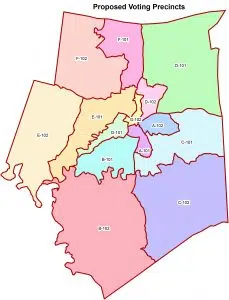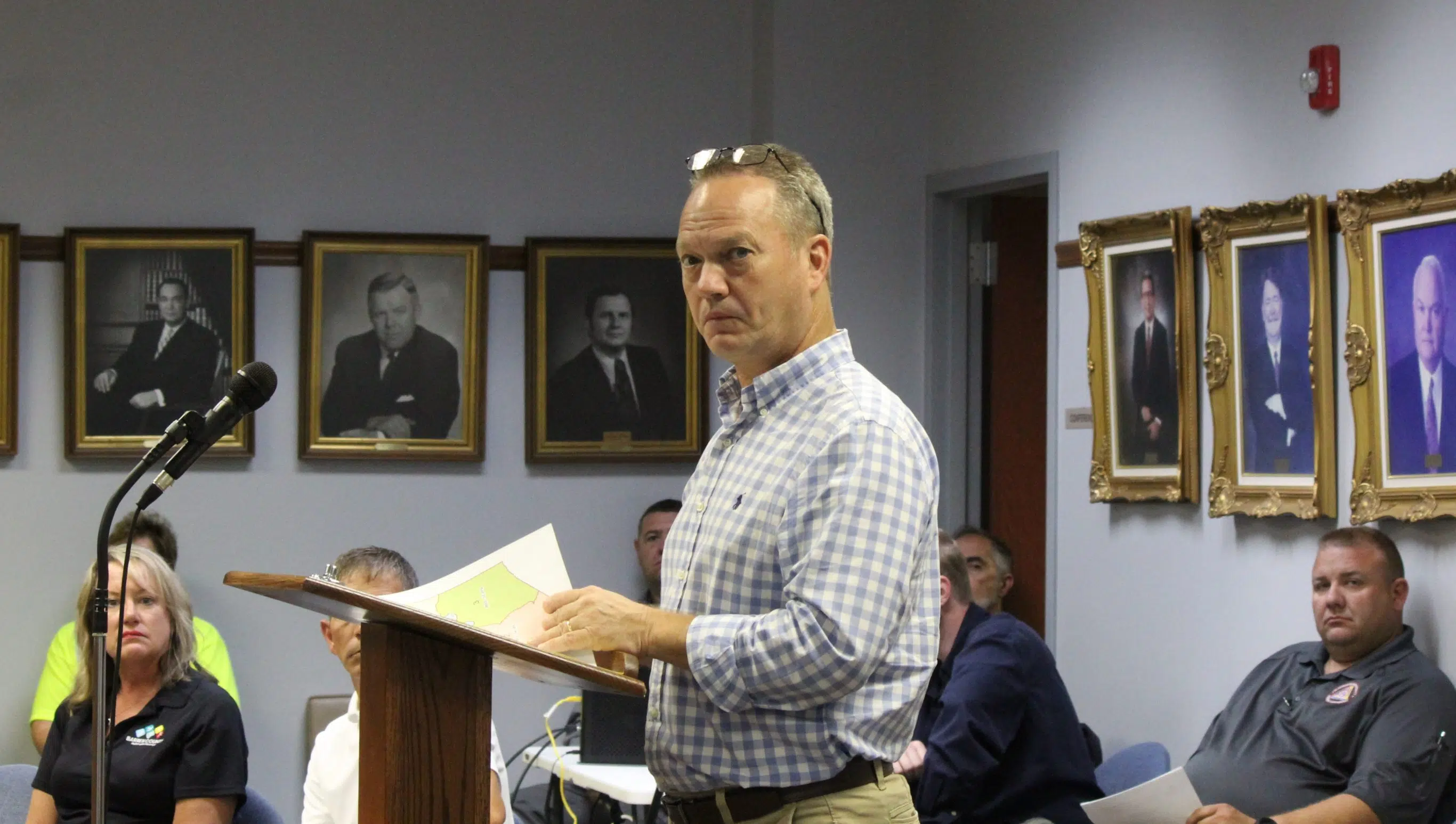By MELINDA J. OVERSTREET
for Glasgow News 1
Committee members appointed to determine the boundary lines for Barren County’s magisterial districts and more, based on the 2020 census figures, brought the panel’s recommendations to the Barren County Fiscal Court for its approval Tuesday.
One quick note to come from the discussion was that the county’s population grew from 42,173 in the 2010 census to 44,485 in the 2020 count, said County Clerk Helena Chase Birdwell.

This map, courtesy of Barrens Information Technology Systems, shows Barren County’s magisterial districts as they would appear if the proposed reapportionment changes are adopted by the fiscal court. It also illustrates segments that were moved from one district to another. They would become effect Jan. 1. The detailed existing magisterial district map is at this link. The proposed new one in detail is at this link.
Though only relatively minor adjustments were made to three of the magisterial districts in the proposed maps, the more significant change is that the county’s number of voting precincts would be reduced from 25 to 14.
Birdwell, who was attending a conference in Lexington but attended the meeting via the Zoom streaming service, said the designated reapportionment group met June 2 and again last week. She expressed gratitude for all the members, but particularly Patrick Staples, geographic information systems manager for Barrens Information Technology Systems.
“We’re very blessed in Barren County to have such an asset from the BITS office,” Birdwell said. “He’s done wonderful work. He put so much time into drawing these maps.”
The other members besides the two of them are Brad Bruton, Joe David Houchens, and the two local political-party representatives on the Barren County Board of Elections, Pat Scott and Mike Harris, are nonvoting members, she said.
“We’re really excited to present to you all this map,” Birdwell said, adding that it would “clean up the lines a little bit for the magisterial districts.”
The districts that had changes were 4, 5 and 6, with 1, 2, 3 and 7 having no adjustments that affect current voters – at least none that affect current voters.
Staples said a geographical adjustment was necessary for District 7, where the Veterans Outer Loop severed Lexington Drive in the vicinity of where it becomes Old Munfordville Road, but there was only one house in the affected area and it was vacant at the time of the census, so there was no population change for that one.
Old Munfordville Road is now a boundary line between Districts 4 and 6, and the proposed changes would put a segment of District 5 that’s “what we call a dog ear,” Staples said, back into District 6.
“So, it just squares it up. It cleans it up a lot,” Staples said.
He said District 4 Magistrate Tim Coomer had expressed some concern over having the same amount of road mileage; some was taken from his district but some was also added, so it essentially evens out.
Staples said the population differences among the districts could be no more than 5 percent, and he said they have it within roughly 1.8 percent.
The detailed existing magisterial district map is at this link. The proposed new one in detail is at this link.

This map, courtesy of Barrens Information Technology Systems, shows Barren County’s voting precincts as they will remain through the end of 2023.
In drawing the new maps, they had to use physical boundaries such as streets, streams, etc., with the use of city limits to be avoided as much as possible, because they can change more easily. He said there is one place in Cave City that uses the city limits, but it’s a radius around the interstate so it’s less likely to change. They were also required to stay within census blocks.
Birdwell said and Staples reiterated later that the Kentucky Board of Elections had advised all the counties that if they had any other general changes that needed to be made, this reapportionment process would be the time to get them done, and Staples said that with the new voting practices, “it’s just a good time to take care of these lines, so it’s basically a house cleaning.”
Staples said the existing precinct map “looks like a big plate of spaghetti to some.”
The voting precincts, unlike the magisterial districts based on total population, have to be based on the numbers of registered voters within them. Staples said the difference in numbers of registered voters from precinct to precinct cannot be more than 2.4 percent.
With the voting-practices changes brought on by the COVID-19 pandemic – allowing any of the county’s registered voters to cast their ballots at any of the designated polling places rather than polling places only within their respective precincts – the need to have at least one polling place in each precinct has gone to the wayside. The reduction in precincts would simplify things considerably for election workers.

This map, courtesy of Barrens Information Technology Systems, shows Barren County’s voting precincts as they would appear if the proposed reapportionment changes are adopted by the fiscal court. They would become effect Jan. 1.
Staples said that even with voters’ being able to vote at any polling place within the county, election results still must be tallied and reported by precinct, so this change should streamline some things on election nights. Even if the county at some point returned to having voting only within the person’s precinct, 14 would be more manageable and less costly than 25, she said.
Birdwell said in one case, the same precinct had portions of three school districts within it and thus three different ballots for the voters there, so these new precinct lines cleans up issues like that as well.
The fiscal court unanimously approved the first reading of the ordinance establishing the new boundaries for districts and precincts. Staples said it has to be advertised and the public has to be given a 20-day response period before the second reading can occur. At that point, it’s provided to state election officials. The new maps are not actually adopted until a second reading is approved, but even with that, the changes would not take effect until 2024, with the primary election being the first one with these new divisions.

Comments